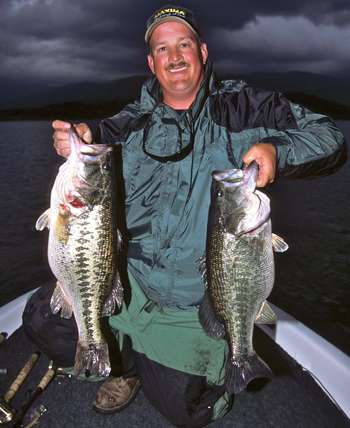
Bill Siemantel is a bass angler’s bass angler.
He’s known for his prowess at catching big bass, but he also competes in tournaments, including 14 career BASS entries (half of which he earned a check in). One of those entries was a win on Lake Powell in 1997.
Siemantel, a career firefighter from Castaic, has always been interested in big bass. He’s an accomplished big bass hunter, having caught more than 400 largemouth weighing more than 10 pounds (when he stopped counting in 2002). Fifty of those weighed better than 15 pounds. His best pushed the scales to 19-13.
He has parlayed his big bass hunting into a promotional career with Spro and their BBZ-1 line of swimbaits, as well as his own personal big bass hunting trademark, complete with a book, co-written with Michael Jones, and a website where fans can interact with the Big Bass Zone founder himself.
“I caught my first truly big bass when I was 10 years old,” said Siemantel. “My dad was an avid angler, but mainly for trout and especially by trolling.”
The pair spent their days on Castaic and Pyramid lakes in a 14-foot aluminum boat with no amenities.
The 42-year-old recounted a tale of meeting an old-school Japanese angler who introduced him and his father to the ways of big plugs for striped bass on the two lakes.
“He made his own wooden plugs and taught us how to do it,” said Siemantel. “We started collecting dowels and table legs — anything we could make big, jointed lures from.”
While they perfected their craft, Siemantel and his father still trolled for trout on Castaic.
“We would troll lead-core line around that place for trout,” he remembered. “We started seeing places where people would anchor and fish live bait for bass.”
He didn’t know it then, but those anglers were anchored on prime bass real estate.
One day Siemantel asked his father to help him tie on one of their big homemade plugs. “He looked at me like I was crazy but did it anyway,” said Siemantel of his father. “We tied it on 18-pound-test lead-core line with a 20-pound-test monofilament leader and started trolling.”
Siemantel let out some line until the bait started to bump bottom, then shortened the amount of line so the bait swam free.
“My dad was still looking at me like I was crazy, but we trolled on,” he said. “We got to the end of our run, and Dad did his turn while the lead-core line made my bait sink.”
As they began to return to course, the youngster, who was becoming lazy from the long slow movement of the boat, began to get sleepy.
“I really thought my dad was messing with me,” said Siemantel. “Because my rod bumped hard and then pulled again.”
It took him a minute to realize what was happening, but he was hooked up with a fish. His father wasn’t so sure.
“He didn’t believe I had a fish until the rod surged. Then he knew I wasn’t snagged,” recalled Siemantel. “I landed the fish, and it was a 10-pound, 8-ounce largemouth.”
That fish opened the youngster’s eyes to a new world — one that involved unconventional tactics and open-minded thinking that serves him to this day.
“We are often so quick to stifle people’s creativity on the water, and it limits people’s effectiveness,” he said. “My dad thought my idea was shortsighted, but he helped me do it anyway, and it showed me a lot.”
That first fish hooked Siemantel more than it did the bass, and armed with a Shimano Baitrunner combo, 20-pound-test monofilament and a selection of striper baits, he would walk the bank at Castaic’s famed Lagoon for many years honing his craft.
“I can still run those same routes and catch big bass to this day,” he said. “Big bass are predictable but elusive; and while we need to have a sense of history, we need to keep an open mind, and that is what I’ve tried to do my whole career.”

